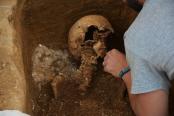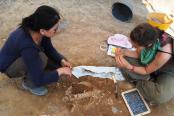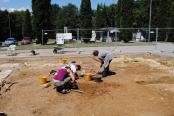CAMPAGNA 2014 |
1° SETTIMANA |
2° SETTIMANA |
3° SETTIMANA |
4° SETTIMANA |
5° SETTIMANA |
6° SETTIMANA |
7° SETTIMANA |
8° SETTIMANA |
27 GIUGNO 2014 
Resoconto della giornata di scavo
Area 2000
Presentiamo di seguito la ricostruzione fotogrammetrica dello scheletro USk 2399, rinvenuto nel Settore B e afferente alla fase del colera del 1855.
E' terminata la documentazione e la rimozione dell'individuo Usk 2399 collegato alla fase di colera. Durante la compilazione della scheda tafonomica è stato possibile determinarne l'età alla morte: si tratta di un uomo tra i 50 e i 60 anni vista la presenza di un marcato lipping (una crescita eccessiva di tessuto osseo) lungo i margini di alcune vertebre toraciche e lombari. L''ottima preservazione delle ossa ha inoltre permesso di determinare l'altezza dell'individuo che doveva essere di circa 1.55 m.
Ancora nel Settore B è stato documentato e rimosso Usk 2389, nella porzione Sud Occidentale; la non completa fusione delle epifisi degli arti inferiori fa credere che si tratti di un giovane di circa 16-17 anni. Il terzo scheletro individuato (Usk 2401 in US -2393), posto poco più a Nord, è stato interamente esposto ed è stato accertato che il taglio sepolcrale a questo associato prosegue in direzione Est, disturbato al centro, come già detto, dalla sepoltura del colera scavata durante la campagna di scavo dello scorso anno (US -2220). Nei prossimi giorni sarà possibile terminare la messa in luce di ciò che rimane degli arti inferiori.
Per ciò che riguarda il Settore A l'attenzione oggi è stata dedicata all'allargamento Ovest. L'accurata pulizia ha permesso di riconoscere uno strato omogeneo che si estende su tutta la superficie (fatta eccezione per la porzione più occidentale) che è stato eguagliato allo strato US 2009 già evidenziato su tutto il settore gli scorsi anni. Fin dalle prime osservazioni è stata notata la presenza di numerosi tagli sepolcrali che si intercettano l'un l'altro, andando a creare situazioni di difficile lettura stratigrafica. Dopo aver riconosciuto alcuni di questi tagli e aver chiarificato i rapporti stratigrafici che li relazionano, si è proceduto all'indagine di US-2402, posta nella porzione centro orientale, e di US-2405, nell'angolo Sud Orientale. Il primo taglio è orientato Ovest Est, ha una forma allungata e irregolare, e all'interno è stato individuato e parzialmente messo in luce Usk 2403; di questo non di si conservano il cranio e i piedi. Il secondo, con stesso orientamento, è stato disturbato da altre sepolture sia a Sud, sia a Ovest che ad Est e all'interno si conservano la tibia e la fibula sinistra non complete e il piede sinistro in connessione (Usk 2406). Posto subito ad Ovest compare un terzo scheletro in connessione anatomica che sarà indagato nei prossimi giorni.
Today we investigated potential cuts in the extended area of 2000 A. We determined that there were two potential cuts and excavated them further; both were located in the southwest corner of area 2000 A and were oriented East to West. Both will be further excavated on Monday to gain a better understanding. The cholera burial in section B of 2000 was further exposed and images, levels and soil samples were taken. More buttons were found inside the chest cavity. The skeleton was removed from the burial to be further analyzed in the lab. Many bones were preserved well by the lime, others including the ribs, vertebrae and pelvis were crumbling. Excavation was continued into the western wall of Area B to expose more of the pelvis of skeleton 2389. After the final cleaning, the bones were removed and packaged for storage. Today we determined that the skeleton was a juvenile male, as the sutures on the distal end of both the left femur and right fibula were incompletely fused, and the degree of the sciatic notch was quite narrow. The medieval burial cut by the two cholera burials on the East side, was also further excavated, revealing most of the chest cavity, the cranium, and the upper limbs. It was then photographed and levels were taken. The lower extremities of the skeleton continued towards the east and are visible in the wall of a previously excavated burial. The eastern cut was defined and photographed and will be excavated on Monday. The filling of this cut was defined by a mottled yellow brown soil surrounded by yellow clay. At the end of the day a cut directly south of the cholera burial in the same north-south orientation in section B was found and his filling was defined by stone and brick inclusions with a silty, medium brown soil surrounded by a similar brown soil that is more compact and clay like. A picture was taken and will be excavated on Monday to verify if it is a cholera burial as well.
Area 3000
Continua l'indagine del Settore B, caratterizato da uno strato a matrice prevalentemente argillo-limosa e di consistenza compatta, ricco di frammenti di laterizi, pietre di varia pezzatura, scisti e nemerose ossa umane, sia sparse che parzialmente in connessione. In particolare, nella porzione sud-orientale dell'area, immediatamente a nord-est del perimetrale sud USM 5003, è stato messo in luce un individuo adulto deposto in decubito dorsale ed orientato S-N. Lo scheletro si presenta in cattivo stato di conservazione e di esso rimane solamente il torace, le mani, probabilmente incrociate sul petto e la porzione superiore del bacino. Il resto del corpo è stato probabilmentte asportato da altri contesti, forse dai tagli di altre fosse sepolcrali che si intercettano a vicenda. Lungo la sezione centro rientale del settore è stata inoltre individuata e scavata una buca di forma subrettangolare, riempita da numerosi elementi litici di varie dimesioni, in parte concotti e vetrificati, scorie metalliche e diversi frammenti di ceramica, sia otto-settecentesca che medievale. Tale fossa, che si estende anche al di sotto della sezione, a sud della porta d'ingresso, era stata probabilmente realizzata con lo scopo di drenare l'acqua dall'edificio religioso. La pulizia del settore ha inoltre permesso la messa in evidenza di alcune fosse sepolcrali, collocate in particolare immediatamente a sud del perimetrale nord USM 3073, che saranno indagate nei giorni seguenti.
Today in Area 3000 the layer was leveled by pick axe, and two of the team members exposed the thorax found yesterday. The body found yesterday includes the vertebral column and a few finger bones. The grave appears to have been destroyed during construction of the asphalt in front of the modern façade. A bone sheet was filled out and pictures were taken to record the position of the thorax in context. The thorax was subsequently bagged for cleaning. Near the center of Sector B, a left tibia and articulated ankle bones were found on the site as well, along with a smashed femur, all of which was bagged for cleaning. No other bones were found in association with the leg bones, also likely due to construction of the asphalt in front of the modern façade. In the sector B south to the door of the modern church, a pit filled with rocks and bricks was excavated. Subsequently a layer of charcoal was discovered that will be further excavated tomorrow in order to better understand it. A drainage trench filled with rocks and bricks that cuts both the pit and the charcoal layer was highlighted. Modern ceramic fragments found in the fill of the trench indicate that the drainage trench is contemporary with the reconstruction of the modern church. Few of the bricks from the fill of the drainage trench appear to be charred to the point of being glazed and also metal slags of a slightly green tint were present. The drainage trench is perpendicular to the façade of the modern church in correspondence of the door and it is aligned to the gap in the façade of the original abbey and it will be fully excavated in the following days. At the end of the day, a final cleaning process for this layer began in Sector A, and will continue into Sector B so that the layer can be documented with all components in context on Monday. More disturbed and undisturbed skeletal material in sector A and B will likely be found on Monday, and after the process of documenting the layer is complete, the team will begin excavation of the known burials from this layer.
Area 4000
Dopo i lavori svolti nel settore B dell'area 5000 e la messa in luce dei contesti rinvenuti durante la precedente campagna di scavo, è iniziata la ripresa dello scavo per quanto riguarda il corridoio occidentale del chiostro. È stata quindi messa nuovamente in luce US 4092, lo strato argilloso occupante l'intera superficie del suddetto corridoio e che un saggio aperto in esso (s. 4800) ha confermato essere il deposito immediatamente superiore ad un gruppo di sepolture probabilmente legate ad i monaci che vivevano il chiostro (ante XV sec.).
Today at the Field Site Badia Pozzeveri we resumed excavation of Area 4,000. This area is known to be a hallway of the cloister area of the old monastery. In previous years there have been two burials discovered in this area. Monks were buried here so that in their death, the living monks would walk over them while praying to deliver them sanctity. We expect to find more burials in this area because of this information. In a normal burial, there will be a visible difference between the ground above a burial and normal ground. This is because the ground used to fill the burial has spent a significant amount of time above ground, therefore changing composition. We determined that when the monks were buried, they were quickly covered, and because of this the fill shows no difference in color from the ground below the body (referred to as the cut). Our main goal for the day was to begin removing small layers of the clay in order to look for evidence of burials. We must proceed slowly in order to minimize the risk of damaging potential burials. Using pick axes and trowels we removed a 5 cm layer of clay, then examined the ground after. Today we have found no evidence of burials and aim to continue this removal Monday.
Area 5000
Nella giornata di oggi si è proceduto con la rimozione del riempimento della canaletta relativa alla tubazione idraulica di età contemporanea (US 5012). Contestualmente è iniziata la rimozione di US 5011, il riempimento argilloso relativo al taglio presente in US 5010 (lo strato ipotizzato come buca per lo spegnimento della calce localizzata nell'angolo sud-occidentale dell'area). Si è cominciata, inoltre, la rimozione di US 5001, uno strato a matrice argillo-sabbiosa, situato nella porzione centro-settentrionale dell'area. Questo sembra obliterare delle lastre di ardesia disposte parallele al terreno e probabilmente in continuità con lo strato presente nella porzione occidentale del sito.
Today was an eventful day in Area 5000. Within the southwest corner, we started excavating the fill of the mortar pit cut. In the process of doing this, we discovered a few pieces of ceramic. The ceramic we found dates from the modern period (1492-1900s). We reached a layer of remaining mortar prior to the clay cut. We must continue excavating this context next week.Running north to south through Areas 3000, 4000, and 5000, there is a water pipe. This was a modern addition and cuts through the medieval contexts of the church. This pipe provides water to the modern day cemetery. The goal of today was to unearth the entirety of the pipe, allowing for it to be moved outside of the excavation area. Clearly, this would make excavation of these sites easier. Unfortuately, while the pipe was being unearthed it was punctured by a trowel, halting further excavations of this item. This project will be reassessed following repairs. The final context that was excavated today extended from the eastern to western edges. This context was taken down a level using pick axes, to partially expose a continuation of the slate layer found earlier in the week. Next week will lead to further soil removal and cleaning of the newly uncovered surface. We hope that further excavation will reveal that this context is a continuation of a previously excavated slate floor from the cloister, located in Area 4000.
















